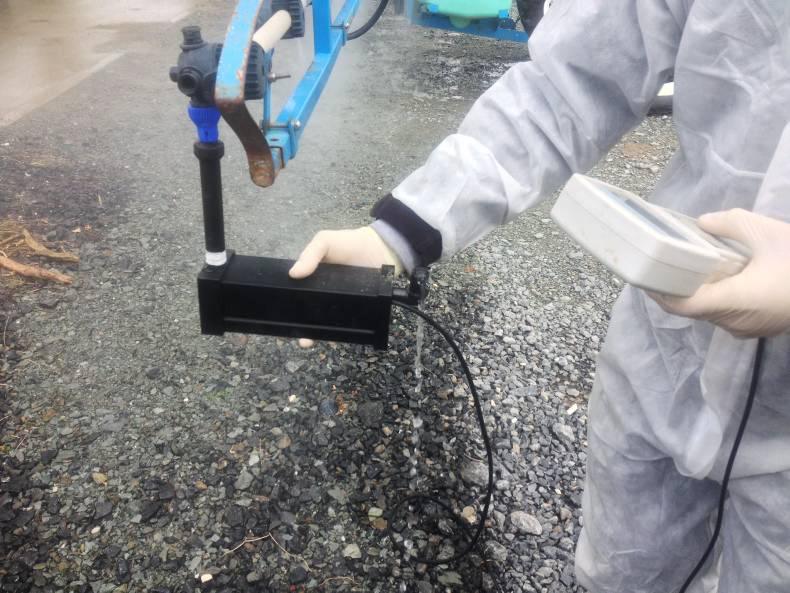This new guideline is to ensure that the sprayer is functioning properly and gets the chemical being used safely on to the target crop without risk to the environment or the operator. But how difficult is this test and what should a sprayer owner do to ensure their sprayer passes?
The sprayer testers course that Teagasc developed and delivers to the DAFM-registered sprayer testers has given us a good insight into what’s needed for the test.
While sprayer owners may think the test is an unnecessary cost, it does ensure that the sprayer is safe and accurate. The main function of a sprayer is to mix and hold the spray product in solution and to apply it evenly with the correct droplet spectrum to the target crop/soil without losing chemical to the environment or risking operator safety. For most sprayers, simple maintenance or repair is all that should be required to pass the test. Here are a few pointers to getting your sprayer through the test.
PTO
Make sure the PTO shaft is properly guarded, otherwise the sprayer will not be tested. Also, a PTO support should be fitted to avoid the PTO being damaged when it’s not attached to the tractor.
Pump
With the biggest nozzles selected and working at maximum nozzle pressure (eg 5 bar), make sure that agitation is visible in the tank, indicating the pump output is sufficient. Check that there are no leaks anywhere on the sprayer or visible pulsations in the nozzle outputs. If there is a problem, check suspect valves, diaphragms etc.
Spray tank
Check the tank and its cover for leaks, that a basket strainer is present under the lid and that the lid incorporates a pressure compensation system. The tank content level must be easily read and you need an emptying tap, or something similar, to allow you to control any emptying procedure. If a self-filler hose is fitted, ensure the non-return valve is working.
Induction hopper
If an induction hopper is fitted, it must be working properly, including the rinse function.
Pressure gauge
Is your pressure gauge accurate? You can check by having a known output nozzle (ie a new nozzle) and checking the flow rate using a stopwatch and graduated cylinder at a set pressure. The scale markings must be at 0.2-bar intervals up to 5 bar. While a 63mm (2.5in) dial-size gauge is acceptable, if you are changing it, get a 100mm dial size, which is easier to read.
Controls generally
All controls for on/off, flow, pressure and section switching should be working without leaks and be accessible from the operator’s seat. If a flow meter is fitted, it will be tested.
Filters and pipes
Make sure you have a suction filter and a pressure filter fitted and that all filters are clean, particularly nozzle filters, if they are fitted. Match the filter mesh sizes with the nozzles to be used. Make sure there are no hose kinks or that it is not worn to the point where woven fabric is visible.
Spray boom
The boom should be generally straight, with all nozzles evenly spaced and angled. The distance to the ground should be within 100mm of each other. Check that the boom break-back works, height adjustment is functioning and that the boom is lockable in transport and that the nozzles are not spraying on the sprayer frame. The suspension, if fitted, should be working properly.
Pressure variation
Check that the section control pressure compensation is working or adjusted correctly, so that when each section is turned off the pressure stays within 10% of target. Also, all hoses and piping should be adequately sized to ensure that the pressure drop from the controller to the nozzle is less than 10% – you need to fit a gauge on to the nozzle holder to check this.
Nozzles and outputs
This is the most important part of the test. You will need a clean tank without contamination, clean filters and a set of good nozzles. Using a stopwatch and graduated cylinder, check the output of a number of nozzles, which should be within 10% of rated output. All nozzles must be identical and anti-drip holders must be fitted and working. The output from all fitted nozzles will be tested to indicate how even the spray pattern is, so good nozzles and clean filters (if fitted) are imperative. If there is more than one set of nozzles fitted, they will all be tested.






 This is a subscriber-only article
This is a subscriber-only article










SHARING OPTIONS: